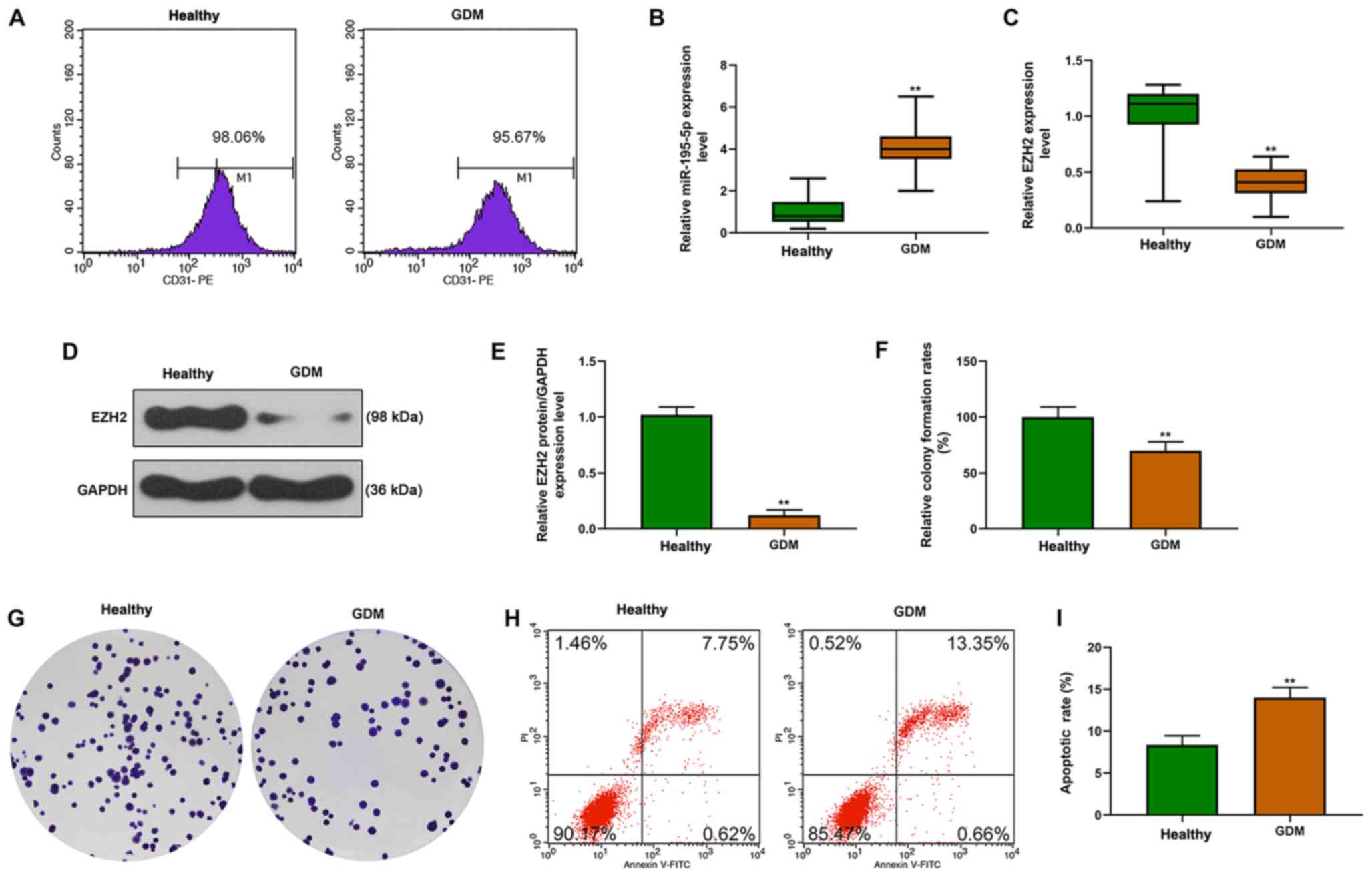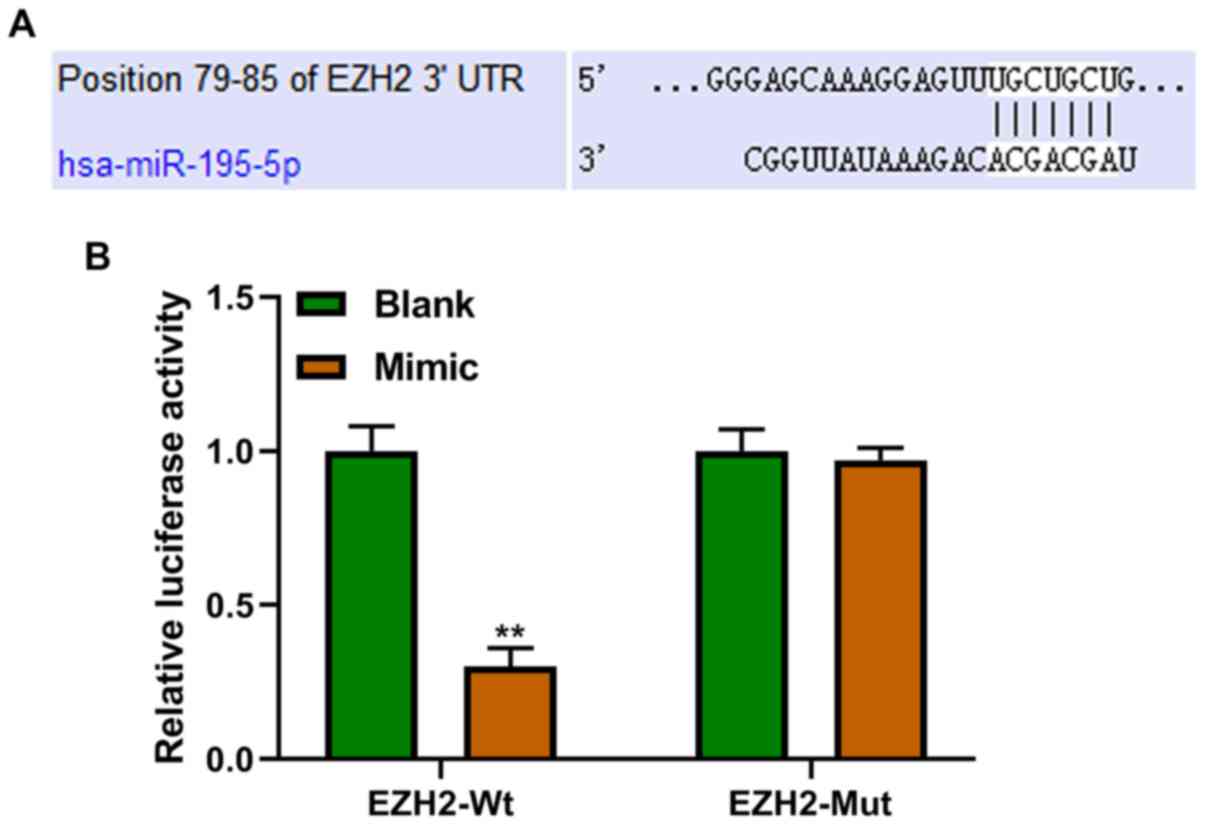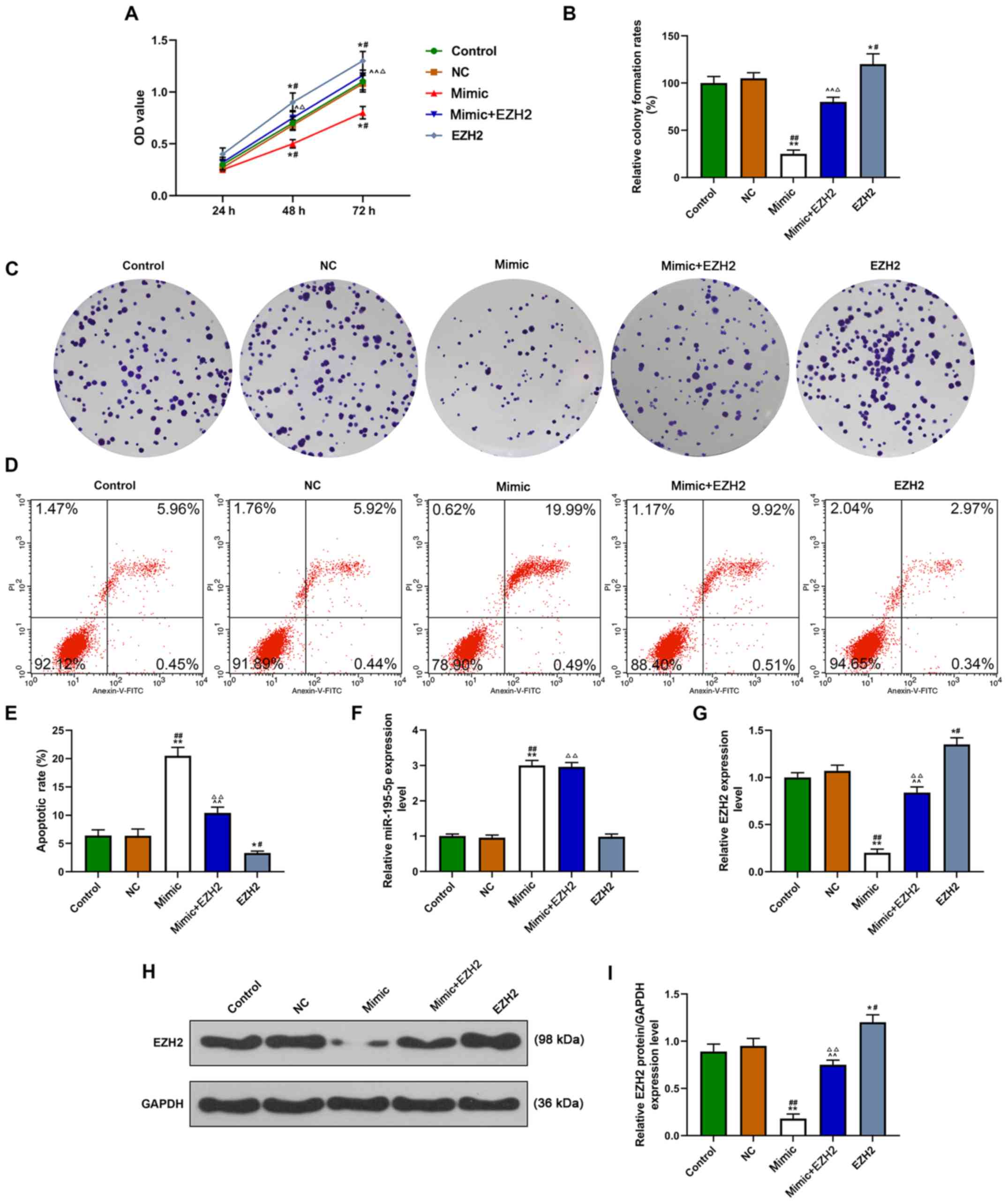|
1
|
Zhang Q, Padi SK, Tindall DJ and Guo B:
Polycomb protein EZH2 suppresses apoptosis by silencing the
proapoptotic miR-31. Cell Death Dis. 5:e14862014. View Article : Google Scholar : PubMed/NCBI
|
|
2
|
Desoye G and Nolan CJ: The fetal glucose
steal: An underappreciated phenomenon in diabetic pregnancy.
Diabetologia. 59:1089–1094. 2016. View Article : Google Scholar : PubMed/NCBI
|
|
3
|
Leach L: Placental vascular dysfunction in
diabetic pregnancies: Intimations of fetal cardiovascular disease?
Microcirculation. 18:263–269. 2011. View Article : Google Scholar : PubMed/NCBI
|
|
4
|
Greene MF and Solomon CG: Gestational
diabetes mellitus-time to treat. N Engl J Med. 352:2544–2546. 2005.
View Article : Google Scholar : PubMed/NCBI
|
|
5
|
Elliott HR, Sharp GC, Relton CL and Lawlor
DA: Epigenetics and gestational diabetes: A review of epigenetic
epidemiology studies and their use to explore epigenetic mediation
and improve prediction. Diabetologia. 62:2171–2178. 2019.
View Article : Google Scholar : PubMed/NCBI
|
|
6
|
Fan Z, Cui H, Xu X, Lin Z, Zhang X, Kang
L, Han B, Meng J, Yan Z, Yan X and Jiao S: MiR-125a suppresses
tumor growth, invasion and metastasis in cervical cancer by
targeting STAT3. Oncotarget. 6:25266–25280. 2015. View Article : Google Scholar : PubMed/NCBI
|
|
7
|
Xie F, Hosany S, Zhong S, Jiang Y, Zhang
F, Lin L, Wang X, Gao S and Hu X: MicroRNA-193a inhibits breast
cancer proliferation and metastasis by downregulating WT1. PLoS
One. 12:e01855652017. View Article : Google Scholar : PubMed/NCBI
|
|
8
|
Wander PL, Boyko EJ, Hevner K, Parikh VJ,
Tadesse MG, Sorensen TK, Williams MA and Enquobahrie DA:
Circulating early- and mid-pregnancy microRNAs and risk of
gestational diabetes. Diabetes Res Clin Pract. 132:1–9. 2017.
View Article : Google Scholar : PubMed/NCBI
|
|
9
|
Tagoma A, Alnek K, Kirss A, Uibo R and
Haller-Kikkatalo K: MicroRNA profiling of second trimester maternal
plasma shows upregulation of miR-195-5p in patients with
gestational diabetes. Gene. 672:137–142. 2018. View Article : Google Scholar : PubMed/NCBI
|
|
10
|
Floris I, Descamps B, Vardeu A, Mitić T,
Posadino AM, Shantikumar S, Sala-Newby G, Capobianco G, Mangialardi
G, Howard L, et al: Gestational diabetes mellitus impairs fetal
endothelial cell functions through a mechanism involving
microRNA-101 and histone methyltransferase enhancer of zester
homolog-2. Arterioscler Thromb Vasc Biol. 35:664–674. 2015.
View Article : Google Scholar : PubMed/NCBI
|
|
11
|
Lewis PW, Muller MM, Koletsky MS, Cordero
F, Lin S, Banaszynski LA, Garcia BA, Muir TW, Becher OJ and Allis
CD: Inhibition of PRC2 activity by a gain-of-function H3 mutation
found in pediatric glioblastoma. Science. 340:857–861. 2013.
View Article : Google Scholar : PubMed/NCBI
|
|
12
|
Xu CR, Li LC, Donahue G, Ying L, Zhang YW,
Gadue P and Zaret KS: Dynamics of genomic H3K27me3 domains and role
of EZH2 during pancreatic endocrine specification. EMBO J.
33:2157–2170. 2014. View Article : Google Scholar : PubMed/NCBI
|
|
13
|
International Association of Diabetes and
Pregnancy Study Groups Consensus Panel, . Metzger BE, Gabbe SG,
Persson B, Buchanan TA, Catalano PA, Damm P, Dyer AR, Leiva A, Hod
M, et al: International association of diabetes and pregnancy study
groups recommendations on the diagnosis and classification of
hyperglycemia in pregnancy. Diabetes Care. 33:676–682. 2010.
View Article : Google Scholar : PubMed/NCBI
|
|
14
|
Matsumoto T, Takaoka E, Ishida K, Nakayama
N, Noguchi E, Kobayashi T and Kamata K: Abnormalities of
endothelium-dependent responses in mesenteric arteries from Otsuka
long-evans Tokushima fatty (OLETF) rats are improved by chronic
treatment with thromboxane A2 synthase inhibitor. Atherosclerosis.
205:87–95. 2009. View Article : Google Scholar : PubMed/NCBI
|
|
15
|
Livak KJ and Schmittgen TD: Analysis of
relative gene expression data using real-time quantitative PCR and
the 2(-Delta Delta C(T)) method. Methods. 25:402–408. 2001.
View Article : Google Scholar : PubMed/NCBI
|
|
16
|
Zinman B, Genuth S and Nathan DM: The
diabetes control and complications trial/epidemiology of diabetes
interventions and complications study: 30th anniversary
presentations. Diabetes Care. 37:82014. View Article : Google Scholar : PubMed/NCBI
|
|
17
|
Cefalu WT and Ratner RE: The diabetes
control and complications trial/epidemiology of diabetes
interventions and complications study at 30 years: The ‘gift’ that
keeps on giving! Diabetes Care. 37:5–7. 2014. View Article : Google Scholar : PubMed/NCBI
|
|
18
|
Hales CN and Barker DJ: The thrifty
phenotype hypothesis. Br Med Bull. 60:5–20. 2001. View Article : Google Scholar : PubMed/NCBI
|
|
19
|
Morwessel NJ: The genetic basis of
diabetes mellitus. AACN Clin Issues. 9:539–554. 1998. View Article : Google Scholar : PubMed/NCBI
|
|
20
|
Pishavar E and Behravan J: miR-126 as a
therapeutic agent for diabetes mellitus. Curr Pharm Des.
23:3309–3314. 2017. View Article : Google Scholar : PubMed/NCBI
|
|
21
|
Assmann TS, Duarte GCK, Brondani LA, de
Freitas PHO, Martins EM, Canani LH and Crispim D: Polymorphisms in
genes encoding miR-155 and miR-146a are associated with protection
to type 1 diabetes mellitus. Acta Diabetol. 54:433–441. 2017.
View Article : Google Scholar : PubMed/NCBI
|
|
22
|
Morais Junior GS, Souza VC, Machado-Silva
W, Henriques AD, Melo Alves A, Barbosa Morais D, Nobrega OT, Brito
CJ and Dos Santos Silva RJ: Acute strength training promotes
responses in whole blood circulating levels of miR-146a among older
adults with type 2 diabetes mellitus. Clin Interv Aging.
12:1443–1450. 2017. View Article : Google Scholar : PubMed/NCBI
|
|
23
|
Shan K, Liu C, Liu BH, Chen X, Dong R, Liu
X, Zhang YY, Liu B, Zhang SJ, Wang JJ, et al: Circular noncoding
RNA HIPK3 mediates retinal vascular dysfunction in diabetes
mellitus. Circulation. 136:1629–1642. 2017. View Article : Google Scholar : PubMed/NCBI
|
|
24
|
Banerjee RR: Piecing together the puzzle
of pancreatic islet adaptation in pregnancy. Ann N Y Acad Sci.
1411:120–139. 2018. View Article : Google Scholar : PubMed/NCBI
|
|
25
|
Lane-Cordova AD, Gunderson EP, Carnethon
MR, Catov JM, Reiner AP, Lewis CE, Dude AM, Greenland P and Jacobs
DR Jr: Pre-pregnancy endothelial dysfunction and birth outcomes:
The coronary artery risk development in young adults (CARDIA)
study. Hypertens Res. 41:282–289. 2018. View Article : Google Scholar : PubMed/NCBI
|
|
26
|
Magee TR, Ross MG, Wedekind L, Desai M,
Kjos S and Belkacemi L: Gestational diabetes mellitus alters
apoptotic and inflammatory gene expression of trophobasts from
human term placenta. J Diabetes Complications. 28:448–459. 2014.
View Article : Google Scholar : PubMed/NCBI
|
|
27
|
Li J, Ying H, Cai G, Guo Q and Chen L:
Impaired proliferation of pancreatic beta cells, by reduced
placental growth factor in pre-eclampsia, as a cause for
gestational diabetes mellitus. Cell Prolif. 48:166–174. 2015.
View Article : Google Scholar : PubMed/NCBI
|
|
28
|
Tryggestad JB, Vishwanath A, Jiang S,
Mallappa A, Teague AM, Takahashi Y, Thompson DM and Chernausek SD:
Influence of gestational diabetes mellitus on human umbilical vein
endothelial cell miRNA. Clin Sci (Lond). 130:1955–1967. 2016.
View Article : Google Scholar : PubMed/NCBI
|
|
29
|
Jin J, Wang C, Ouyang Y and Zhang D:
Elevated miR-195-5p expression in deep vein thrombosis and
mechanism of action in the regulation of vascular endothelial cell
physiology. Exp Ther Med. 18:4617–4624. 2019.PubMed/NCBI
|
|
30
|
Xu J, Wang Z, Lu W, Jiang H, Lu J, Qiu J
and Ye G: EZH2 promotes gastric cancer cells proliferation by
repressing p21 expression. Pathol Res Pract. 215:1523742019.
View Article : Google Scholar : PubMed/NCBI
|
|
31
|
Li Y, Li D, Zhao M, Huang S, Zhang Q, Lin
H, Wang W, Li K, Li Z, Huang W, et al: Long noncoding RNA SNHG6
regulates p21 expression via activation of the JNK pathway and
regulation of EZH2 in gastric cancer cells. Life Sci. 208:295–304.
2018. View Article : Google Scholar : PubMed/NCBI
|
|
32
|
Lian R, Ma H, Wu Z, Zhang G, Jiao L, Miao
W, Jin Q, Li R, Chen P, Shi H and Yu W: EZH2 promotes cell
proliferation by regulating the expression of RUNX3 in laryngeal
carcinoma. Mol Cell Biochem. 439:35–43. 2018. View Article : Google Scholar : PubMed/NCBI
|
|
33
|
Yan JJ, Chang Y, Zhang YN, Lin JS, He XX
and Huang HJ: miR-195 inhibits cell proliferation via targeting
AEG-1 in hepatocellular carcinoma. Oncol Lett. 13:3118–3126. 2017.
View Article : Google Scholar : PubMed/NCBI
|
|
34
|
Yin Y, Hong S, Yu S, Huang Y, Chen S, Liu
Y, Zhang Q, Li Y and Xiao H: MiR-195 inhibits tumor growth and
metastasis in papillary thyroid carcinoma cell lines by targeting
CCND1 and FGF2. Int J Endocrinol. 2017:61804252017. View Article : Google Scholar : PubMed/NCBI
|
|
35
|
Han Li C and Chen Y: Targeting EZH2 for
cancer therapy: Progress and perspective. Curr Protein Pept Sci.
16:559–570. 2015. View Article : Google Scholar : PubMed/NCBI
|
|
36
|
Li Z, Hou P, Fan D, Dong M, Ma M, Li H,
Yao R, Li Y, Wang G, Geng P, et al: The degradation of EZH2
mediated by lncRNA ANCR attenuated the invasion and metastasis of
breast cancer. Cell Death Differ. 24:59–71. 2017. View Article : Google Scholar : PubMed/NCBI
|
|
37
|
Pepin ME, Bickerton HH, Bethea M, Hunter
CS, Wende AR and Banerjee RR: Prolactin receptor signaling
regulates a pregnancy-specific transcriptional program in mouse
islets. Endocrinology. 160:1150–1163. 2019. View Article : Google Scholar : PubMed/NCBI
|

















